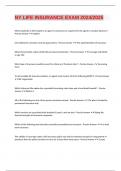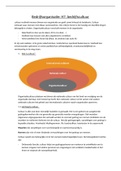Lecture: Introduction to financial management
Financial management is the process of financial decision-making within an organization that aims to
meet the organization’s (financial) goals efficiently and effectively.
Elements of financial management
1. Decisions: where and how much to invest?
2. Control: is the business meeting its objectives?
3. Planning: how to ensure enough funding at the right time?
Why healthcare financial management?
The complexity of healthcare management decisions:
- Population’s health (quality, accessibility, ethics)
- The business “health” (cost recovery, profitability)
- Rising health care costs – factors and solutions (reimbursement, technology, administration,
merger)
- Business orientation of the health care organizations, versus ethical standards
Costs
= accounting costs (monetary value of production inputs)
Why are costs important?
- Planning, e.g. to estimate unit-cost price and financial results
- Evaluation and control, e.g. to monitor financial performances
- Decision-making, e.g. to set market prices, to decide on investments
,Case 1: Renovation or contracting out?
LITERATURE:
Books
• Baker JJ, Baker RW, Dworkin NR. (2017). Health care finance: basic tools for nonfinancial managers,
5th Edition. Jones & Bartlett Learning. CHAPTER 13.
• Finkler SA, Ward DM, Calabrese T. (2018). Accounting fundamentals for health care management,
3rd Edition. Jones & Bartlett Learning. CHAPTER 15.
• Gruen R, Howarth A. (2005). Financial management in health services. Open University Press.
CHAPTER 19.
Articles
• Mead M, Atkinson T, Srivastava A, Walter N. (2019). The return on investment of orthopaedic
fellowship training: a ten-year update. Journal of the American Academy of Orthopaedic Surgeons,
Oct 29.
• Mukherjee T, Rahahleh NA, Lane W. (2016). The capital budgeting process of healthcare
organizations: a review of surveys. Journal of Healthcare Management, 61(1):58-76.
• Yoo S, Kim S, Kim T, et al. (2012). Economic analysis of cloud-based desktop virtualization
implementation at a hospital. BMC Medical Informatics and Decision Making, 12:119.
• Penton ME, Otto C, Hammerschlag MR. (2019). Outsourcing microbiology services in medical
centers
1. What is meant by ‘investment’ and by ‘capital’ investment?
Investment
In finance, an investment is a monetary asset purchased with the idea that the asset will provide
income in the future or will later be sold at a higher price for a profit. However, there are many
definitions. In every field, the definition will differ.
Capital investment (CI)
CI refers to the funds invested in the organization by its owner. Capital investment represents:
- Major monetary investments
- Expected to achieve long-term benefits
- Undertaken with the aim to assure the financial survival of an organization
Types of capital investment
- Material investment: purchase of a medical equipment, introduction of a management
information system
- Financial investment: purchase of shares, bonds, options.
2
,Importance of capital investment
2. What is investment analysis and what are its steps? What is time-value?
Investment analysis in long-term projects is often named as capital budgeting. With an
investment analysis, you evaluate long-term investment opportunities. An investment analysis
must be able to assess whether the expected return can compensate for risk you are taking.
Steps
Step 1. Identification of the investment needs (i.e. analyze whether is necessary to invest)
Step 2. Identification of all possible investment alternatives
Step 3. What are the investment features? (i.e. what are the values of investment alternatives)
Step 4. Comparison of the alternative investments
Comparison based on the values; evaluation of the alternatives using investment features (step 2:
financial characteristics), the outcome of step 3 and qualitative information is used to compare
the alternatives. Thus, a total of: financial criteria and qualitative aspects (e.g. strategic
advantage, image, goal to e.g. become the most innovative hospital etc.)
Step 5. Selection of one of the investment alternatives (take into account financial and non-
financial criteria)
Step 6. Methods of investment funding (i.e. how to fund the investment? See LG 5)
Time-value
Time value of money refers to the fact that money received at different points in time is equally
valuable. So, the value of a dollar of today is more than the value of a dollar in the future.
Time-value can be seen as opportunity costs for waiting to get your money back. You could have
also invest your money in something else. An organization would always prefer to receive cash
sooner and pay cash later, because cash can be invested and earn a return in exchange for its
use.
Current financial flows are worth more than the future flows. So, investment analysis must
account for time differences in financial flows!
3
, Key concepts in time-value analysis
- Present value (PV) = today’s value of financial flows
- Future value (FV) = future’s value of financial flows
- Compounding = transformation from present to future value
-Discounting = transformation from future to present value
3. How to select an investment option? Methods to be considered: payback (PB) period, net-
present value (NPV), internal rate of return (IRR), return on investment (ROI). What are the
possible pros and cons of these methods?
Investment appraisal techniques are based on the assumption that the main aim of a capital
investment project is to generate a return on the investment. There are three elements that
determine the return of an investment:
- The sum invested
- Returns on the sum invested
- The lifetime of the project
A. Payback period (PB) – static
This method is used where the early return of funds is importance, e.g. when the organization
has liquidity problems. The shorter the payback period, the better the project.
+ Quick and dirty evaluation
- Ignores what happens after the payback period, e.g. project A may have the shortest payback
period, but project B will return more in a four-year period
- PB doesn’t take into account the time value of money
B. Net present value (NPV) – dynamic
This methods takes account of time preferences people have in returns over time. So, earns the
project more or less than the stated desired rate of return? This desired/required rate of return
is called the hurdle rate. An acceptable project should be higher than this rate. This rate concerns
1) the compensation for investing the money in the project and 2) the risk inherent the project.
Once you know this rate, the NPV method can be used to assess whether a project is acceptable.
Discounting
Discounting allows to determine what a future cash flow is worth today. So, it takes into account
of investing the amount in alternative ways and allows the future returns of the investment be
compared to its present value. The discount rate is the percentage by which future returns are
adjusted to consider the underlying time preference.
The discount rate is the required rate of return to compensate for:
- Risk of the investment
- Temporary loss of funds (opportunity costs)
4
, + Takes account of the time value of money
- However, neither interests rates not cash flows can be estimated with absolute certainty so this
will always be a guess
- NPV never indicates what rate of return a project is earning. You simply find out whether it is
earning less or more than the specified hurdle rate. The only thing you is when NPV > 0 = project
accepted (higher rate of return than r%) & NPV < 0 = project rejected (lower rate of return than r
%). When NPV = 0, the rate of return is equal to r%.
Literally the difference between the money inflow and the money outflow over a period of
time
C. Internal rate of return (IRR) – dynamic
As stated at the NPV method, you never know the exact rate of return of a project. When you set
NPV equal to zero, and you will find out the rate the average rate of return on an investment
throughout its lifetime. So, IRR is when NPV = 0.
+ Enables a comparison with other rates of return on investment.
- Focusing on IRR exclusively ignores the actual value in monetary terms of the return on
investment so you will always need the NPV as well.
- The interpretation of IRR can be misleading, e.g. an IRR of 10% on a large capital could be a
better investment than an IRR of 15% on a smaller capital.
D. Return on investment (ROI) – static
ROI is a performance measure used to evaluate the efficiency of an investment or compare the
efficiency of a number of different investments. ROI tries to directly measure the amount of
return on a particular investment, relative to the investment’s cost. To calculate ROI, the benefit
(or return) of an investment is divided by the cost of the investment. The result is expressed as a
percentage or a ratio.
+ ROI is a ratio that compares what you invested and what you get in return, so it makes you able
5











